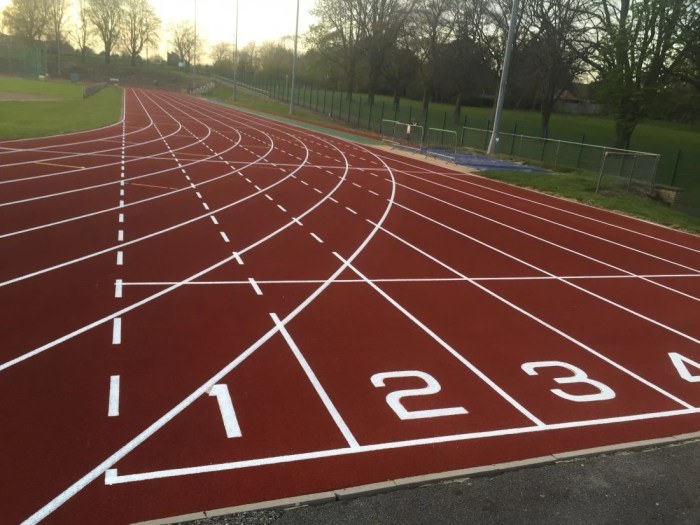
Track and field injury prevention is a critical aspect of athletic performance that ensures athletes can compete at their best without the hindrance of injuries. Understanding the various techniques, including effective warm-up and cool-down routines, is essential for reducing the risk of common injuries associated with these sports.
By implementing proper stretches and strength training exercises, athletes can enhance their resilience and maintain optimal physical condition. This exploration delves into the most prevalent injuries in track and field, their causes, and the preventative measures that can be taken to safeguard athletes.
Injury Prevention Techniques in Track and Field

In the world of track and field, injury prevention is crucial for maintaining athletic performance and longevity in the sport. A combination of effective warm-up and cool-down routines, targeted stretching, and specific strength training exercises can significantly reduce the risk of injuries among athletes. Understanding and implementing these strategies can help athletes stay healthy and perform at their best.
Warm-up and Cool-down Routines
A proper warm-up prepares the body for the physical demands of track and field events by increasing blood flow to the muscles and enhancing flexibility. Similarly, cool-down routines help to gradually lower the heart rate and promote recovery after intense physical activity. The following components are essential in both warm-up and cool-down routines:
- Dynamic Warm-up Exercises: Activities such as high knees, butt kicks, and leg swings increase heart rate and activate the muscles. Aim for at least 10-15 minutes of dynamic stretching before training or competition.
- Static Stretching: This should be reserved for the cool-down phase. Focusing on major muscle groups helps to improve flexibility and reduce muscle tightness. Include stretches like hamstring stretches and quadriceps stretches for about 5-10 minutes post-activity.
- Mobility Drills: Incorporating mobility exercises like ankle circles and hip openers during warm-ups helps prepare joints and muscles for the specific movements in track and field.
Common Stretches for Injury Reduction
Incorporating targeted stretches into training can help alleviate muscle tightness and improve overall flexibility, which is essential for injury prevention. Here are some effective stretches that track and field athletes should consider:
- Hamstring Stretch: Sit on the ground with one leg extended and reach towards your toes. Hold for 15-30 seconds for each leg to improve hamstring flexibility.
- Quadriceps Stretch: Stand on one leg and pull the opposite foot towards your glutes. This stretch targets the quadriceps and should also be held for 15-30 seconds on each side.
- Calf Stretch: Position yourself with one foot in front of the other and lean forward, keeping your back leg straight. This stretch helps to maintain calf muscle elasticity.
- Hip Flexor Stretch: Kneel on one knee with the other foot in front, creating a 90-degree angle. Lean forward gently to stretch the hip flexors, holding for 15-30 seconds.
Strength Training Exercises for Injury Prevention
Strength training plays a vital role in injury prevention by enhancing muscle stability and joint integrity. A well-structured strength program can complement an athlete’s track and field training while minimizing the risk of injuries. The following exercises are particularly beneficial:
- Squats: This foundational movement strengthens the quadriceps, hamstrings, and glutes. Variations such as bodyweight squats, goblet squats, or barbell squats can be integrated depending on the athlete’s experience level.
- Lunges: Forward, reverse, and lateral lunges target multiple muscle groups and improve balance and coordination. Incorporating weighted lunges can further enhance strength.
- Planks: Core stability is essential for track and field athletes. Planks engage various muscle groups and can be modified with side planks or plank leg lifts to increase difficulty.
- Deadlifts: This exercise focuses on the posterior chain, strengthening the back, glutes, and hamstrings. Proper form is crucial to prevent injury during this compound movement.
“Preventing injuries through proper warm-up, stretching, and strength training is as important as the training itself.”
Coaching Insight
Understanding Track and Field Injuries
Track and field, known for its diverse events ranging from sprints to distance running, throws, and jumps, is not without its risks. Athletes participating in these events are susceptible to various injuries, stemming largely from the high-impact nature of the sport, improper technique, or inadequate conditioning. Understanding the types of injuries that commonly occur in track and field can help in developing effective prevention and management strategies.The most prevalent injuries in track and field typically include sprains, strains, stress fractures, and tendonitis.
Sprains often occur in the ankle due to the quick direction changes inherent in many events, while strains can affect muscles like the hamstrings or quadriceps, commonly from overexertion. Stress fractures, particularly in the lower leg or foot, result from repetitive impact, and tendonitis, especially in the knees or Achilles tendon, arises from overuse. Climate, surface conditions, and training volume also significantly contribute to these injuries.
Statistics on Injury Rates in Track and Field
Understanding the frequency of injuries in track and field relative to other sports highlights its risk factors. While the overall injury rate in track and field is approximately 15-20%, studies indicate this is lower than sports like football and basketball, which have injury rates exceeding 30%. Factors such as event type, age, and experience play a role in these statistics, with younger athletes often experiencing higher injury rates due to developing bodies and less experience in technique.
Common Track and Field Injuries, Symptoms, and Treatments
Addressing the specific injuries prevalent among track and field athletes is crucial for effective treatment and recovery. Below is a table summarizing some of the common injuries, associated symptoms, and recommended treatments:
| Injury | Symptoms | Treatment |
|---|---|---|
| Ankle Sprain | Pain, swelling, bruising, difficulty walking | R.I.C.E. (Rest, Ice, Compression, Elevation), physical therapy |
| Hamstring Strain | Pain at the back of the thigh, swelling, bruising | R.I.C.E., rehabilitation exercises, gradual return to activity |
| Stress Fracture | Localized pain during activity, swelling, tenderness | Rest, immobilization, gradual return to sport as pain allows |
| Achilles Tendonitis | Pain and stiffness in the Achilles area, swelling | Rest, ice, stretching exercises, physical therapy |
“Early diagnosis and appropriate rehabilitation are key to minimizing the impact of track and field injuries on performance.”
In summary, awareness of the common injuries in track and field, their causes, and appropriate treatments can significantly impact athletes’ overall performance and well-being.
Cross-Sport Injury Prevention Insights
In the realm of sports, understanding injury prevention across various disciplines can provide valuable insights for athletes and coaches alike. Track and field athletes can benefit from examining the strategies employed in other sports such as martial arts and water sports. By comparing these approaches, we can elevate our understanding of how to mitigate injuries effectively, regardless of the sport.
Comparison of Injury Prevention Strategies
The strategies implemented in martial arts and water sports often highlight the significance of flexibility, core strength, and mental conditioning. In martial arts, techniques such as controlled movements and proper body alignment are emphasized, which can directly influence injury reduction. Practitioners often focus on developing proprioception and balance, which are key components that can also enhance performance in track and field.Conversely, water sports require a unique blend of endurance and resistance training.
Athletes often face different types of stress on their bodies due to the water’s buoyancy and resistance. Critical injury prevention methods in these sports include warm-up routines that prioritize muscle activation and joint health, similar to track and field. For instance, swimmers often incorporate strength training sessions focused on their upper body to prevent shoulder injuries, a concept that can be adapted to track athletes to strengthen their legs and core.
Application of Strength Sports Principles
Principles from strength sports can significantly contribute to injury prevention in track and field. The focus on building foundational strength through weight training helps athletes develop the necessary muscle support for their joints. For example, squats and deadlifts play a pivotal role in reinforcing leg muscles, which are essential for sprinters and jumpers. Incorporating Olympic lifting techniques can enhance explosive power, which not only improves performance but also reduces the risk of strains and sprains during competition.
A well-structured strength training program should include exercises targeting the entire body, ensuring balanced muscle development that protects against injury.
Importance of Proper Equipment and Footwear
The role of appropriate equipment and footwear in preventing injuries cannot be overstated. In track and field, specialized shoes are designed to provide the necessary support and cushioning for various events. Athletes should always choose footwear that matches their specific event requirements, for example, spikes for sprints versus cushioned shoes for long-distance running.In martial arts, protective gear such as shin guards and padded uniforms help minimize impact injuries during training and competition.
Similarly, in water sports, wearing gear such as wetsuits can provide both thermal protection and buoyancy, thereby reducing the risk of injuries from falls or collisions. Proper maintenance and the timely replacement of gear play a critical role in injury prevention across all sports. Worn-out shoes or equipment can lead to increased risk of injuries, underscoring the need for athletes to remain vigilant about their gear condition.
The right equipment and proper technique are the first lines of defense against sports injuries.
Closing Notes

In summary, prioritizing injury prevention in track and field not only enhances performance but also ensures athletes can pursue their passion safely. By understanding the common injuries, employing effective prevention techniques, and drawing insights from other sports, athletes can significantly reduce their injury risks and enjoy a long and fulfilling career.
Key Questions Answered
What is the importance of a warm-up routine?
A warm-up routine prepares the body for physical activity, increasing blood flow to muscles and reducing the risk of injuries.
How can I identify if I have a track and field injury?
Common symptoms include pain, swelling, and limited range of motion in the affected area. If these symptoms persist, it’s best to consult a healthcare professional.
What types of shoes are best for track and field?
Specific running or track shoes designed for your event type provide better support and grip, reducing injury risks.
How often should I perform strength training?
Incorporating strength training 2-3 times per week can significantly enhance injury prevention and overall athletic performance.
Can stretching prevent injuries?
Yes, regular stretching improves flexibility and range of motion, which can help prevent injuries during training and competition.





